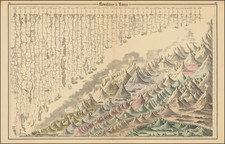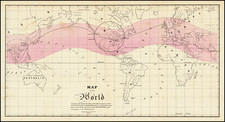Antique engraved diagram showing the schematics for a galley, one of the largest ships in the Venetian Navy at the time when it was the foremost military power in the western Mediterranean. Engraved by one of the great Italian cartographers of the 17th century, Vincenzo Maria Coronelli, this work first appeared in his Atlante Veneto.
Several different views of the galley are presented, including a plan view and a cross-sectional view. Two additional views show the construction of the oars and the operation of the rudder. Note the navigator's chained foot, likely to prevent him from falling overboard.
The extensive index shows a schematic for a typical galley. Indices AA-EE provide dimensions for the major features, including the maximum length, the water depth, and the length of the keel. Additional letters provide descriptions of the other parts of the ship, describing the masts, helm, and rudder in detail.
Coronelli's Atlante Veneto was intended to accompany Blaeu's Atlas Maior and contained abundant maps. However, due to the idiosyncratic nature of the publication of the book, images of Coronelli's ships are rarer today than his maps are.
Vincenzo Maria Coronelli (1650-1718) was one of the most influential Italian mapmakers and was known especially for his globes and atlases. The son of a tailor, Vincenzo was apprenticed to a xylographer (a wood block engraver) at a young age. At fifteen he became a novice in a Franciscan monastery. At sixteen he published his first book, the first of 140 publications he would write in his lifetime. The order recognized his intellectual ability and saw him educated in Venice and Rome. He earned a doctorate in theology, but also studied astronomy. By the late 1670s, he was working on geography and was commissioned to create a set of globes for the Duke of Parma. These globes were five feet in diameter. The Parma globes led to Coronelli being named theologian to the Duke and receiving a bigger commission, this one from Louis XIV of France. Coronelli moved to Paris for two years to construct the King’s huge globes, which are 12.5 feet in diameter and weigh 2 tons.
The globes for the French King led to a craze for Coronelli’s work and he traveled Europe making globes for the ultra-elite. By 1705, he had returned to Venice. There, he founded the first geographical society, the Accademia Cosmografica degli Argonauti and was named Cosmographer of the Republic of Venice. He died in 1718.









![(Horse Diving) [Original photograph of Sonora Carver on her horse Red Lips in mid-air diving off a platform]](https://storage.googleapis.com/raremaps/img/small/96798.jpg)

![[Grotto of Tethys -- Versailles] Le Soleil qui se couche dans la mer / Le Globe de la Terre, divise en six parties.](https://storage.googleapis.com/raremaps/img/small/79606.jpg)


![[Charles Lindbergh] Our Hero](https://storage.googleapis.com/raremaps/img/small/67612.jpg)